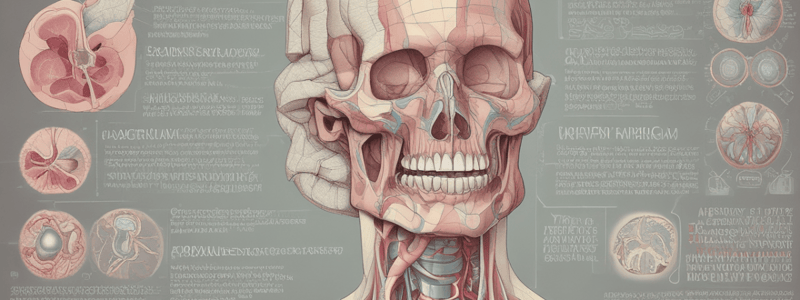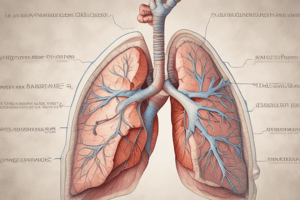Podcast
Questions and Answers
What is the function of the pulmonary ligament in the lungs?
What is the function of the pulmonary ligament in the lungs?
- Attaches the lung to the mediastinum (correct)
- Attaches the lung to the thoracic cage
- Separates the lungs into lobes
- Supports the trachea
What is the number of lobes in the right lung?
What is the number of lobes in the right lung?
- 5
- 4
- 3 (correct)
- 2
Which surface of the lung bears the hilum?
Which surface of the lung bears the hilum?
- Costal surface
- Mediastinal surface (correct)
- Diaphragmatic surface
- Pleural surface
Where does the oblique fissure of the lung intersect with the 5th rib?
Where does the oblique fissure of the lung intersect with the 5th rib?
What is the weight of the left lung?
What is the weight of the left lung?
What is the location of the ascultation site for the pleural cavities?
What is the location of the ascultation site for the pleural cavities?
What is the surface of the lung that rests on the dome of the diaphragm?
What is the surface of the lung that rests on the dome of the diaphragm?
What is the uppermost part of the lung that ascends into the neck?
What is the uppermost part of the lung that ascends into the neck?
What is the shape of a bronchopulmonary segment?
What is the shape of a bronchopulmonary segment?
Which of the following segments is not a part of the superior lobe of the right lung?
Which of the following segments is not a part of the superior lobe of the right lung?
What lies in the connective tissue between adjacent bronchopulmonary segments?
What lies in the connective tissue between adjacent bronchopulmonary segments?
Where is the auscultation site for the superior lobe of the left lung?
Where is the auscultation site for the superior lobe of the left lung?
What is the characteristic of a bronchopulmonary segment that makes it a surgical unit?
What is the characteristic of a bronchopulmonary segment that makes it a surgical unit?
What is the auscultation site for the basal segment of the lower lobe?
What is the auscultation site for the basal segment of the lower lobe?
What is the purpose of the pleural fluid in the pleural cavity?
What is the purpose of the pleural fluid in the pleural cavity?
Which part of the parietal pleura receives innervation from the phrenic nerve?
Which part of the parietal pleura receives innervation from the phrenic nerve?
What is the name of the line of pleural reflection that forms the boundary between the costal and mediastinal pleura?
What is the name of the line of pleural reflection that forms the boundary between the costal and mediastinal pleura?
Which of the following statements is true about the pleural cavities?
Which of the following statements is true about the pleural cavities?
Which part of the parietal pleura is in contact with the mediastinal pleura in the costomediastinal recess?
Which part of the parietal pleura is in contact with the mediastinal pleura in the costomediastinal recess?
What is the name of the recess formed by the lowermost part of the costal pleura and the peripheral diaphragmatic pleura?
What is the name of the recess formed by the lowermost part of the costal pleura and the peripheral diaphragmatic pleura?
Study Notes
Pleura and Pleural Cavity
- Visceral pleura completely covers the lung and extends into interlobar fissures.
- Pleural cavity is a potential space between visceral and parietal pleura.
- Pleural fluid is a capillary layer of serous fluid that lubricates the pleural surfaces and allows the layers of pleura to slide smoothly over each other during respiration.
Parietal Pleura
- Covers internal surface of thoracic wall, with three main divisions:
- Costal pleura: covers internal surface of thoracic wall.
- Mediastinal pleura: covers lateral aspects of mediastinum.
- Diaphragmatic pleura: covers thoracic surface of diaphragm on each side of the mediastinum.
- Cervical pleura (pleural cupula) extends through the superior thoracic aperture into the root of the neck, forming a cup-shaped dome over the apex of the lung.
Innervation of Parietal Pleura
- Parietal pleura sensitive to pain, temperature, touch, and pressure.
- Costal pleura innervated by intercostal nerves.
- Mediastinal pleura innervated by phrenic nerve.
- Diaphragmatic pleura innervated by phrenic nerve (domes) and lower 6 intercostal nerves (periphery).
Visceral Pleura
- Sensitive to stretch.
- Innervated by pulmonary plexus.
Lines of Pleural Reflection
- Sternal line of pleural reflection.
- Costal line of pleural reflection.
- Vertebral line of pleural reflection.
Recesses
- Costodiaphramatic recess: lowermost part of costal pleura and peripheral diaphragmatic pleura.
- Costomediastinal recess: smaller recesses posterior to the sternum where the costal pleura is in contact with the mediastinal pleura.
Bronchopulmonary Segment
- A subdivision of a lung lobe.
- Pyramidal in shape, apex toward the root of the lung, base at pleural surface.
- Surrounded by connective tissue.
- Has segmental bronchus, segmental artery, lymph vessels, and autonomic nerves.
- Segmental vein lies in the connective tissue between adjacent bronchopulmonary segments.
- A diseased segment can be removed surgically.
Bronchopulmonary Segments of Right and Left Lungs
- Right lung: 10 segments (superior, middle, and inferior lobes).
- Left lung: 10 segments (superior and inferior lobes).
Auscultation Sites
- Apex: medial 1/3 of the clavicle anteriorly and upper part of the supraclavicular region posteriorly.
- Superior lobe of right lung: clavicle to 4th costal cartilage.
- Superior lobe of left lung: clavicle to 6th costal cartilage.
- Middle lobe: 4th-6th ribs in front of the midaxillary line.
- Apical or superior segment of lower lobe: posteriorly in the interval between medial border of scapula and the vertebral spines.
- Basal segment of the lower lobe: posteriorly in the infrascapular region up to 10th rib.
Pulmonary Ligament
- At the root of the lung, the visceral and parietal pleural layers are continuous.
- A double layer of parietal pleura hangs inferiorly from this region.
Lungs
- Each lung lies free in its own pleural cavity, attached to the mediastinum only by the root of the lung and pulmonary ligament.
- Grayish black in adults, pink in children.
- Weight: left lung (550g), right lung (600g).
- The right lung is broader and shorter than the left due to the liver pushing the dome of the diaphragm upwards.
- Lobar divisions: right lung (3 lobes), left lung (2 lobes).
- Fissures: right lung (oblique and horizontal), left lung (oblique).
- Oblique fissure: lateral to T3, 5th rib in the midaxillary line, and 7-8 cm lateral to 6th costal cartilage.
- Horizontal fissure: right 4th intercostal cartilage and rib meet the oblique fissure in the midaxillary line.
Characteristics of Lungs
- Rounded apex.
- Costal, diaphragmatic, and mediastinal surfaces.
- Anterior, inferior, and posterior borders.
- Apex: blunt superior end of the lung ascending above the level of the 1st rib into the neck, covered by cervical pleura.
Surfaces of the Lung
- Costal surface: adjacent to the sternum, costal cartilages, and ribs.
- Diaphragmatic surface: resting on the dome of the diaphragm.
- Mediastinal surface: bears the hilum.
Studying That Suits You
Use AI to generate personalized quizzes and flashcards to suit your learning preferences.
Related Documents
Description
A quiz about the characteristics of bronchopulmonary segments, including their shape, structure, and functions.




